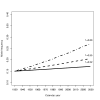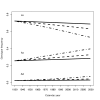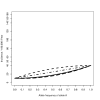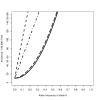Increasing incidence of Type 1 diabetes--role for genes?
- PMID: 15059244
- PMCID: PMC400729
- DOI: 10.1186/1471-2156-5-5
Increasing incidence of Type 1 diabetes--role for genes?
Abstract
Background: The incidence of Type 1 diabetes (T1DM) is increasing fast in many populations. The reasons for this are not known, although an increase in the penetrance of the diabetes-associated alleles, through changes in the environment, might be the most plausible mechanism. After the introduction of insulin treatment in 1930s, an increase in the pool of genetically susceptible individuals has been suggested to contribute to the increase in the incidence of Type 1 diabetes.
Results: To explore this hypothesis, the authors formulate a simple population genetic model for the incidence change driven by non-Mendelian transmission of a single susceptibility factor, either allele(s) or haplotype(s). A Poisson mixture model is used to model the observed number of cases. Model parameters were estimated by maximizing the log-likelihood function. Based on the Finnish incidence data 1965-1996 the point estimate of the transmission probability was 0.998. Given our current knowledge of the penetrance of the most diabetic gene variants in the HLA region and their transmission probabilities, this value is exceedingly unrealistic.
Conclusions: As a consequence, non-Mendelian transmission of diabetic allele(s)/haplotype(s) if present, could explain only a small part of the increase in incidence in Finland. Hence, the importance of other, probably environmental factors modifying the disease incidence is emphasized.
Figures

 = 0.15 in both figures. The transmission distortion effect is assumed to have been acting since the introduction of insulin in 1930s.
= 0.15 in both figures. The transmission distortion effect is assumed to have been acting since the introduction of insulin in 1930s.
 = 0.15 in both figures. The transmission distortion effect is assumed to have been acting since the introduction of insulin in 1930s.
= 0.15 in both figures. The transmission distortion effect is assumed to have been acting since the introduction of insulin in 1930s.



References
-
- Llanos G, Libman I. Diabetes in the Americas. Bull Pan Am Health Organ. 1994;28:285–301. - PubMed
-
- Karvonen M, Tuomilehto J, Libman I, LaPorte R, for the World Health Organization DIAMOND Project Group A review of the recent epidemiological data on the worldwide incidence of Type 1 (insulin-dependent) diabetes mellitus. Diabetologia. 1993;36:883–892. - PubMed
-
- Tuomilehto J, Virtala E, Karvonen M, Lounamaa R, Pitkaniemi J, Reunanen A, Tuomilehto-Wolf E, Toivanen L. Increase in incidence of insulin-dependent diabetes mellitus among children in Finland. Int J Epidemiol. 1995;24:984–992. - PubMed
-
- Joner G, Sovik O. Increasing incidence of diabetes mellitus in Norwegian children 0–14 years of age 1973–1982. Diabetologia. 1989;32:79–83. - PubMed
Publication types
MeSH terms
Grants and funding
LinkOut - more resources
Full Text Sources
Other Literature Sources
Medical
Research Materials

